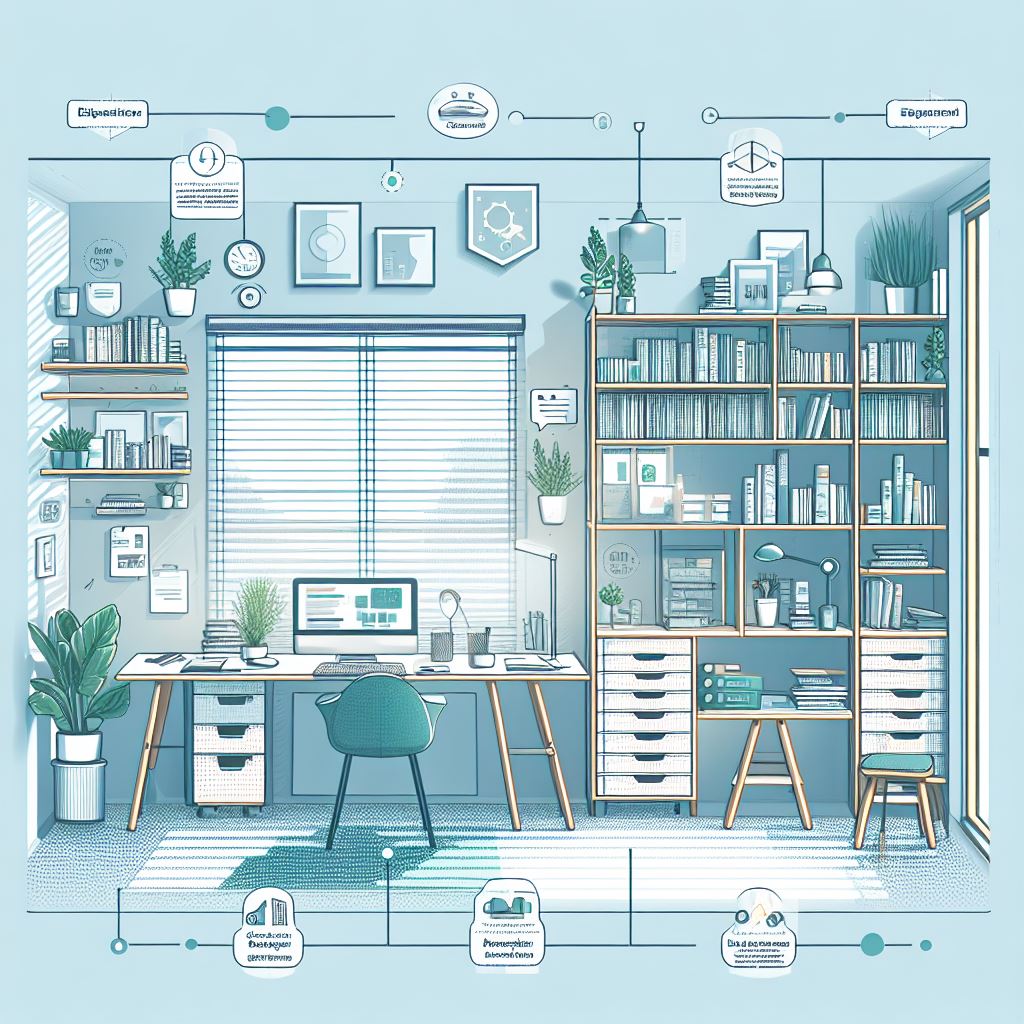
Organizing Your Study Space for Maximum Productivity
Introduction
A study space is not just a physical locale; it’s a mental fortress where ideas bloom and learning prospers. The organization of your study area can directly impact your productivity levels and learning capabilities. This comprehensive guide will delve into the art and science of creating an optimal learning environment, offering practical advice, proven methods, and valuable insights for students, remote workers, lifelong learners, educators, and parents.
For
- High School, College, and Graduate Students
- Remote Workers
- Lifelong Learners and Self-Taught Individuals
- Educators and Tutors
- Parents Setting up Study Spaces for Children
Psychological Impact of Study Space Organization
Organized vs. Disorganized Environment
An organized study area fosters a sense of control and focus, reducing stress and distractions. Scientific evidence underscores that clutter and disorganization can hinder the thinking process and affect one's mood negatively. In contrast, a well-organized space can significantly enhance focus and boost productivity.
Quote:
"Clarity affords focus." – Thomas Leonard
Scientific Evidence
Several studies endorse the positive impact of organized spaces on productivity and mental well-being. A study by the Princeton University Neuroscience Institute found that clutter competes for attention and results in decreased performance and increased stress.
Common Mistakes in Setting up Study Spaces
- Overcrowding: Including too many items can lead to distraction.
- Poor Lighting: Insufficient light can strain the eyes and affect concentration.
- Ignoring Ergonomics: Uncomfortable furniture can lead to physical strain over time.
- Neglecting Ambiance: The aesthetic and feel of the space are often overlooked, impacting mood and motivation.
Case Study: Transforming Study Spaces
A college student, struggling with focus and productivity, transformed his cluttered and chaotic study zone into an organized, distraction-free area. By implementing strategic lighting, ergonomic furniture, and minimizing unnecessary items, he experienced a noticeable improvement in focus and academic performance.
Practical Tips and Techniques
Steps to Design an Effective Study Environment
- Assess Your Needs: Identify the essential items and materials.
- Prioritize Lighting: Ensure the space is well-lit, preferably with natural light.
- Choose Ergonomic Furniture: Opt for comfortable and adjustable furniture.
- Manage Cables: Keep cords and cables organized and out of the way.
- Designate Specific Areas: Have distinct zones for different activities, like reading, writing, and digital work.
Tips for Decluttering and Arranging Study Spaces
- Purge Unnecessary Items: Remove items that do not serve a purpose.
- Utilize Storage Solutions: Use shelves, baskets, and boxes to organize materials.
- Keep Essentials Within Reach: Position frequently used items close by.
- Maintain a Clean Desk: Regularly clear the desk of unnecessary items.
Maximizing Productivity through Study Room Organization
- Implement Time Management Techniques: Use tools and methods like the Pomodoro Technique to allocate time efficiently.
- Set Clear Goals: Define what you aim to accomplish during each study session.
- Minimize Distractions: Keep mobile devices and other distractions at bay.
- Create a Schedule: Plan study sessions and breaks to maintain a balanced routine.
Quote:
"Productivity is never an accident. It is always the result of a commitment to excellence, intelligent planning, and focused effort." – Paul J. Meyer
Influence of Lighting, Furniture, and Ambiance

Lighting
Appropriate lighting is crucial. It not only reduces eye strain but also boosts mood and concentration. Natural light is the most beneficial, but adjustable, and well-placed artificial light can also be effective.
Furniture
Ergonomic furniture minimizes the risk of discomfort and injury, allowing for prolonged periods of study or work without physical strain. It contributes to maintaining focus and increasing productivity in the learning environment.
Ambiance
The ambiance of a study space, including color schemes, décor, and overall aesthetic, plays a significant role in enhancing mood, motivation, and the willingness to learn.
Example:
A study by the University of Texas found that bland colors like white, beige, and gray induced feelings of sadness and depression, while colors like green and blue improved focus and efficiency, particularly for prolonged study sessions.
Benefits of a Well-Organized Study Area
- Enhanced Focus: Minimizes distractions, allowing for better concentration.
- Increased Productivity: Promotes an efficient workflow and time management.
- Reduced Stress: An organized environment decreases anxiety and overwhelm.
- Improved Learning: Supports optimal learning conditions and fosters academic success.
Conclusion
Organizing your study space is not just about physical arrangement; it's about creating a harmonious learning environment that aligns with your needs, preferences, and academic or professional goals. From decluttering to establishing proper lighting, every element contributes to building a productive and positive workspace. Embrace the best methods to organize your study space, implement practical tips diligently, and experience a substantial upsurge in your productivity and learning capabilities.
Parting Words
"The secret of your future is hidden in your daily routine." – Mike Murdock
Remember, an organized study space is a stepping stone towards a more focused, productive, and fulfilled academic and professional life.
References
(Ensure to list relevant and credible references and sources to back up the claims and points mentioned in the article.)
Inspirable Story:
|
Once upon a time, in a bustling town brimming with ambitious learners, lived a college student named Alex. Alex was a hardworking student with dreams as high as the clouds but was often found wrestling with concentration amidst the chaos of his cluttered study room. The disarray around him seemed to echo the disorganization within his thoughts, and productivity seemed like a distant, elusive goal. One day, with determination swirling in his heart, Alex decided to transform his chaotic study zone into a sanctuary of learning. He yearned to create a space where focus wasn’t a fleeting visitor but a loyal companion, a place where every learning seed could flourish into a tree of knowledge. Alex embarked on this journey with meticulous research, unearthing the connection between organized spaces and one's mental well-being. He learned that an orderly environment was like a serene melody that tuned his mind to the symphony of learning, allowing his thoughts to dance in harmony, free from the noise of clutter. So, with newfound insights, he rolled up his sleeves and began his mission of transformation. He purged his room of unnecessary items, a breath of freshness replacing the stagnant air laden with remnants of procrastination. He organized his books, study materials, and digital tools, each finding a home within shelves, baskets, and boxes. Alex paid heed to the lighting, ensuring it bathed his room in a warm, comforting glow, a beacon of focus in his learning journey. He understood that the right light was a silent whisperer of motivation, guarding his eyes from strain and his mind from the shadows of distraction. He embraced ergonomic furniture, the comfort cradling his body, allowing him to delve deep into his studies without the shackles of physical discomfort. The ambiance of his room transformed; colors of blue and green painted his walls, whispering words of focus and efficiency to his eager mind. Alex felt the change; it was like the chains of chaos had been broken, liberating his thoughts to soar in the limitless skies of learning. Productivity wasn’t a mirage anymore; it was the ground he stood on, firm and real. His study sessions were no longer battles; they were harmonious symphonies of learning, each note a word, each melody a concept understood. The organized space was a silent composer, orchestrating his thoughts into symphonies of understanding and knowledge. His friends marveled at the transformation, not just of his study space but his demeanor. The ripple effect of his organized sanctuary echoed through his life, bringing waves of positivity, focus, and unyielding productivity. Alex’s story became a beacon of inspiration, illuminating the path for all the learners in the town, guiding them to the shores of organized learning and boundless knowledge. Alex’s journey teaches us that an organized study space is not merely a physical arrangement. It’s a harmonious blend of elements, a silent nurturer of thoughts, a cradle for focus, and a cultivator of learning. It’s the unspoken whisperer of motivation, a silent builder of dreams, a companion in one’s journey to the peaks of knowledge. And remember, just like Alex, every learner holds the brush to paint their canvas of learning, to create a masterpiece of organized thoughts, to dance in the harmonious tunes of focus, and to soar in the boundless skies of knowledge. So, let’s all embark on this beautiful journey and create our sanctuaries of learning, transforming not just our spaces but our lives. |





